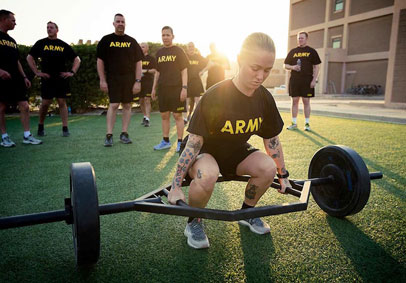The Army Fitness Test (AFT) is the official physical fitness test of the U.S. Army. It’s a fairly complex test designed to assess multiple components of physical fitness, including sex- and age-specific standards for males and females, with separate sex-neutral standards anticipated for certain combat roles. This article discusses each test component and provides exercise suggestions to optimize your training.
3-rep Max Deadlift
This deadlift measures lower-body muscular strength. You’ll do the test with a 60-lb “trap bar”—a hexagon-shaped barbell—as opposed to a standard straight barbell. To excel, you’ll need to practice your deadlift technique and train to improve lower-body muscular strength for several weeks leading up to the test. You’ll only have 2 attempts at this test, and it will be important to know roughly what your 3RM is so you can maximize your score. Watch HPRC’s deadlift instructional videos for tips on how to perfect your technique. Even though it’s demonstrated with a straight bar in both videos, the same technique applies when using a trap bar.
Hand-Release Push-up (HRP)
The HRP tests muscular endurance, requiring you to do as many hand-release push-ups as you can in 2 minutes. Unlike a regular push-up, the HRP starts with you lying flat on the ground with your hands under your shoulders. You start by pushing up from the ground, then perform the downward motion of the push-up, going all the way down to lie on your chest and pick your hands up off the ground. While lying on the ground, straighten your arms out to the sides, so your arms are at a 90-degree angle with your body (like a T-shape). The best training for this test will be a combination of core-stability and pushing exercises.
Sprint-Drag-Carry
This test consists of five, 50-m shuttles, each requiring different strengths. Here’s how to excel at each event:
- The sprint is a measure of straight-line running speed. Read HPRC’s article on the need for speed for some training ideas.
- The 90-lb sled drag is designed to simulate a casualty drag. You’ll do one shuttle by dragging a 90-lb sled backwards. This event will really burn your quads, so try to add squats, lunges, and deadlifts to your training plan.
- The lateral shuffle measures agility and should be done as described in Military Movement Drill 1 of the Army's Holistic Health and Fitness (H2F) field manual.
- The 2 × 40-lb kettlebell carry tests muscular endurance. You’ll carry a 40-pound kettlebell in each hand through the 50-m shuttle, similar to carrying ammo and jerry cans. For tips, see HPRC’s article on carrying–foundational movements, especially the farmer’s carry video.
- Repeat the first sprint.
Plank
This event is a standard plank exercise to measure core-muscle endurance, requiring you to hold a set position for as long as you can. Training for this event will be similar to training for the HRP. Core stability exercises and upper-body muscular endurance will help maximize your plank performance.
2-mile Run
The 2-mile run is the last event of the AFT and tests your cardiorespiratory endurance. Planning a variety of run-training sessions over time is the best way to improve your run time.
Helpful Resources
If you’re relatively new to resistance training, workout planning for beginners will help you design your plan. Those with more experience might want to learn more about block periodization as well. Visit the AFT website for scoring tables, how-to videos, safety tips, program updates, and more.
Updated: June 10, 2025
